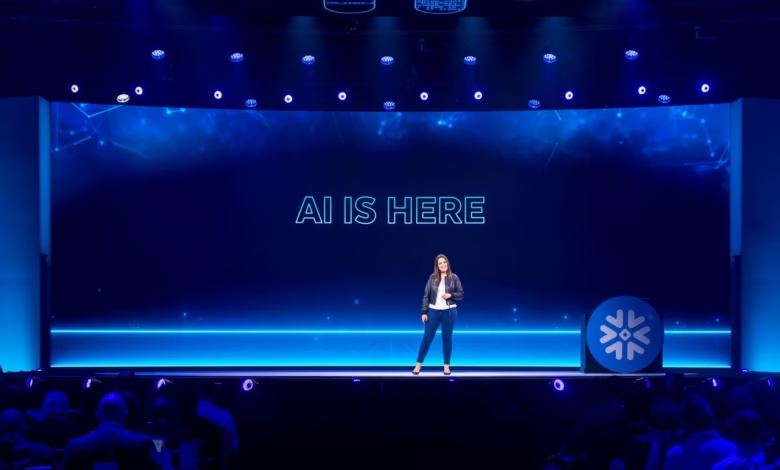AI’s Next Frontier: Databases Over Big Models

▼ Summary
– The AI race is shifting focus from advanced models to fast, reliable data infrastructure, with companies like Snowflake, Databricks, and Salesforce making major database acquisitions.
– AI tools require high-quality, real-time data to function effectively, making database performance and accessibility critical for modern AI workflows.
– PostgreSQL, while reliable for traditional uses, faces limitations in handling AI-driven, real-time data demands, prompting companies to rethink database architectures.
– Snowflake is investing in real-time AI workflows, integrating transactional systems and generative AI to enable seamless data access and decision-making for businesses.
– Enterprises struggle with scaling AI due to poor data readiness, highlighting the need for robust infrastructure to bridge the gap between AI ambitions and practical execution.
The future of AI isn’t just about smarter algorithms, it’s about faster, more reliable data infrastructure. Recent high-profile acquisitions by major tech players signal a seismic shift in where the real competition lies. Instead of focusing solely on building larger language models, companies are racing to dominate the database layer, recognizing that AI is only as powerful as the data fueling it.
Snowflake’s $250 million purchase of Crunchy Data, Databricks’ $1 billion acquisition of Neon, and Salesforce’s $8 billion deal for Informatica all point to one undeniable trend: the battle for AI supremacy is moving downstream. While cutting-edge models still capture attention, the real differentiator is now the ability to deliver high-speed, resilient, and scalable data to power AI-driven workflows.
Why Databases Are the New AI Battleground
AI tools, whether chatbots, copilots, or predictive analytics, depend on vast amounts of structured and unstructured data. Without seamless access to real-time, high-quality information, even the most advanced models falter. As one industry expert bluntly put it, “AI is useless without good data.”
PostgreSQL, the open-source database backbone of countless enterprise systems, has long been a trusted solution. But traditional databases weren’t designed for the relentless demands of AI. Real-time AI agents require continuous reads and writes, global data consistency in milliseconds, and fault tolerance, capabilities that legacy systems struggle to provide.
This gap explains why companies like Snowflake are reimagining database architecture. By integrating transactional and AI-ready systems directly into their platforms, they’re enabling businesses to support intelligent, real-time decision-making without bottlenecks.
The Push for Real-Time Data Workflows
At Snowflake’s recent summit, CEO Sridhar Ramaswamy highlighted a strategic pivot toward “workflow-native” data platforms. Tools like Openflow and Snowflake Intelligence aim to bridge the divide between corporate data and AI applications, allowing companies to unify fragmented data sources, from on-prem databases to SaaS apps, into cohesive, actionable pipelines.
Snowflake Intelligence takes this a step further by embedding generative AI directly into enterprise data. Employees can now query complex datasets using natural language, eliminating the need for SQL expertise or engineering support. According to Jeff Hollan, head of Cortex AI apps and agents, “The next wave of AI isn’t just data-hungry, it’s reasoning-hungry.”
This shift underscores a broader industry transformation. Batch analytics are giving way to continuous data interaction, where systems must adapt to real-time decision-making. Snowflake’s Cortex AI framework exemplifies this evolution, automating operations and delivering business value in live environments, far beyond the experimental phase where many companies remain stuck.
The Growing AI Execution Gap
Despite widespread enthusiasm for AI, many enterprises struggle to scale their initiatives. A recent report revealed that 42% of AI projects fail or underperform due to poor data readiness, highlighting the disconnect between ambition and infrastructure.
Vivek Raghunathan, Snowflake’s SVP of engineering, notes that “without the right foundational systems, AI investments won’t yield lasting results.” Organizations must move beyond experimentation and ensure their data architecture can support real-time, production-grade AI workflows.
The Bottom Line
Snowflake, Databricks, and Salesforce’s aggressive moves into the database space send a clear message: the future of AI hinges on data infrastructure. As AI transitions from labs to live deployments, the winners won’t just have the smartest models, they’ll control the most robust data stacks.
For businesses, this means reevaluating their data strategies now. The database layer is no longer a backend concern, it’s the frontline of AI competitiveness. Those who fail to prioritize it risk falling behind in the race to harness AI’s full potential.
(Source: Forbes)
